Stroud and COP26: Equipping Stroud’s homes for the future

By Jamie O’Dell
In Stroud, emissions from our homes are the one of the largest sources of greenhouse gas emissions, second only to those caused from transport. This is part of a wider UK trend where 19% of our total emissions come from homes and buildings, with the UK having one of the least energy efficient housing stock in Europe. Meaning that we collectively burn more fossil fuels to heat our homes for less heat. In sum, our homes aren’t fit for the future.
At the same time, 5,240 households in Stroud – 10.2% – are classed as fuel poor. Cold houses are not just uncomfortable, they’re unsafe. Previous studies have found that cold housing puts you more at risk of heart and lung disease and worsens conditions like arthritis and rheumatism.
The effect on children and young people’s future health and wellbeing is also shocking. One review into these impacts, led by Micheal Marmot, found that children in cold homes are twice as likely to suffer from a variety of respiratory problems than those in warm homes.
So in our homes, we have one of the clearest intersections between climate action and social injustice, and by tackling this issue at scale, we can drastically reduce our carbon emissions while increasing our health by ensuring everyone has access to a warm home. But with over 53,000 households across the Stroud area this is clearly a huge issue, so how do we tackle it.
The simple answer is a national program to retrofit the UK’s housing stock with low carbon heating technologies and proper insulation, while expanding our renewable electricity capacity and keeping household bills affordable. Different homes will also require different solutions, this explainer from Nailsworth Climate Action Network provides a very useful introduction to the basics of retrofit.
Evidently the simple solution does not have a simple delivery mechanism. This was demonstrated by the failure of the government’s £1.5 billion Green Home Grant (GHG) last year. Without a coherent national plan, sufficient long term funding and the workforce skills and supply chain, the national aspects of the GHG failed. There is hope, however, in how this contrasts to the delivery of retrofit programs by local authorities, who are in much better positions to build and deploy skills and supply chains locally.
This is why it is encouraging to see Stroud District Council planning for the district’s future through a £180 million investment in the energy efficiency and carbon reduction of over 5,000 council homes over the next 30 years. But while the solution may rest with local authorities, the problem of a lack of financial investment sadly does not. Before the financial pressures Covid-19 has caused, the spending power of councils has been reduced by a third during the previous decade of Conservative austerity.
Empowering councils like SDC should therefore be a key priority of the government’s. Yet, despite increased funding through schemes such as the Social Housing Decarbonisation Fund in the government’s recent Heat and Buildings Strategy – which SDC was already receiving funding from – the level of funding from the government remains shockingly short of what is required.
In their 2019 election manifesto, the Conservatives pledged £9.2 billion towards energy efficiency measures and even in the wake of their major new strategies, they are £2 billion short. When we factor in that £9.2 billion, of which only £6.6 is intended for delivery by 2025, it in itself billions short of what is estimated to be required to get us on track to decarbonising our homes, then the failure of the government to tackle this issue becomes ever more apparent.
What’s more, in key areas such as heat pump installations the government is seemingly betting it all on ‘market mechanisms’ delivering the required level of installations rather than public investment, a move that not even right-wing think tanks are hiding their concerns over. This is before we consider that heat pumps need well insulated housing that can retain heat in order to be efficient and cost effective, meaning that an investment in low-carbon heating is undermined if not accompanied by energy efficiency measures.
Home energy efficiency measures are considered to be one of the low-hanging fruits of climate action. Significant cuts to emissions and energy use, warmer homes, new jobs. This is reflected in how much of the attention over home heating and retrofit has been focused upon inter-Conservative party clashes over the ‘cost of net-zero’ and replacing the nation’s gas boilers with low-carbon alternatives like heat pumps. Even Stroud MP Siobhan Baillie has been vocal on the urgent need to tackle the green skills emergency.
While this may be progress on previous years, the level of investment by the government and their betting on the invisible hand of the market demonstrates that we are still well behind where we could and should be in the fight to ensure warm, well insulated and carbon free homes in Stroud. Local councils and Climate Action Networks can do all the sterling work they are able to, but it is Westminster where the issue lies, and shifting power and resources from there to Ebley Mill would be one of the most effective ways to equip Stroud’s homes for a greener future.






Member discussion